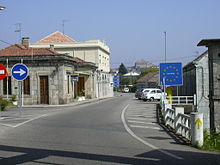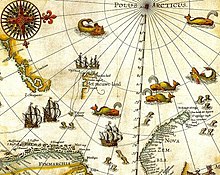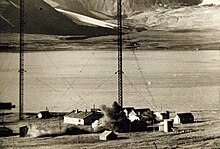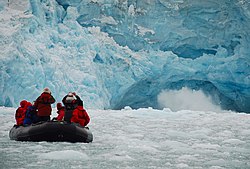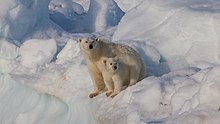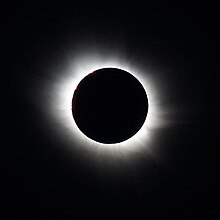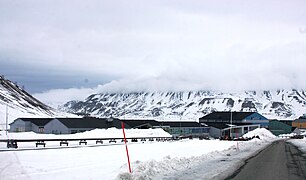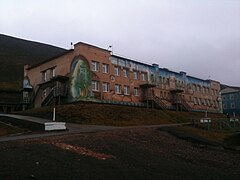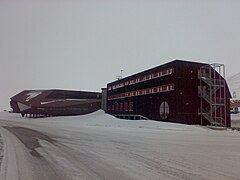Border between Spain and Portugal, members of the Schengen Agreement. Their border is marked with a simple sign and no passport checks or customs controls.
An open border is a border that enables free movement of people (and often of goods) between jurisdictions with few or no restrictions on movement, that is lacking substantive border control. A border may be an open border due to intentional legislation allowing free movement of people across the border (de jure),
or a border may be an open border due to a lack of legal controls, a
lack of adequate enforcement or adequate supervision of the border (de facto). An example of the former is the Schengen Agreement between most members of the European Economic Area (EFTA and the EU). An example of the latter has been the border between Bangladesh and India, which is becoming controlled. The term "open borders" applies only to the flow of people, not the flow of goods and services, and only to borders between political jurisdictions, not to mere boundaries of privately owned property.
Open borders are the norm for borders between subdivisions within the boundaries of sovereign states, though some countries do have controlled borders within the boundaries of the state (for example in the People's Republic of China between the mainland and the special administrative regions of Hong Kong and Macau). Open borders are also usual between member states of federations (such as the United States of America), though again in some instances movement between member states may be controlled via an internal passport
system. Federations and confederations typically maintain external
border controls through a collective border control system, though they
sometimes have open borders with other non-member states (particularly enclaves, such as Switzerland and the European Union) through special international agreements.
Pervasive international border control is a relatively recent
phenomenon in world history. In the past, many states had open
international borders either in practice or due to a lack of any legal
restriction. Many authors, such as John Maynard Keynes, have identified the early 20th century and particularly World War I as the point when such controls became common.
There have been sporadic attempts to promote global open borders as a viable policy option. Open borders quickly became popular after 1889.
The International Emigration Conference held in Rome in May 1924 stated
that anybody has the right to immigrate to a different country if they
wanted to.
Before the 1880s, migration to the United States was not fully
controlled. During World War I it became easier for people to migrate
from their country of origin to foreign countries. After World War II, countries were looking for many new workers, and Germany issued a guest work program to attract more people to work. Later, in the 1970s to 1980s strict borders were reinstated in industrialized countries. Currently, immigration is more restricted and harder for low-skilled and low-income people.
Types of borders
There are multiple types of national borders in use around the world. Some of these are:
A conditionally open border is a border that allows
movement of people across the border that meet a special set of
conditions. This special set of conditions which limits the application
of border controls that would normally otherwise apply could be defined
by an international agreement or international law, or the special
conditions could be defined by a regulation or law of the jurisdiction
that the people are claiming the right to enter. Conditionally open
borders generally requires a claim to be submitted from the people who
are proposing to enter the new jurisdiction stating why they meet the
special conditions which allow entry into the new jurisdiction. The new
jurisdiction may detain the people until their claim is approved for
entry into the new jurisdiction, or they may release them into the new
jurisdiction while their claim is being processed. Whenever a
conditionally open border is allowed, a considerable effort is often
required to ensure that border controls do not break down to such an
extent that it becomes an open border situation. An example of a
conditionally open border is a border of any country which allows
movement of asylum seekers due to application of either the 1951 Refugee
Convention or international law which allows people to cross a border
to escape a situation where their lives are directly threatened or in
significant danger. Another example is the border between Ireland and the United Kingdom. The two countries allow unrestricted movement of their own citizens, but in order to enjoy such movement across the Irish Sea,
those same citizens may be required to provide evidence at seaports and
airports that they are UK or Irish nationals. These checks are by the
police, not immigration officers. (As of October 2018, there are no such controls on the highly porous land border between them).
A controlled border is a border that allows movement of
people between different jurisdictions but places restrictions and
sometimes significant restrictions on this movement. This type of border
may require a person crossing this border to obtain a visa
or in some cases may allow a short period of visa free travel in the
new jurisdiction. A controlled border always has some method of
documenting and recording people movements across the border for later
tracking and checking compliance with any conditions associated with the
visa or any other border crossing conditions. A controlled border
places limitations on what a person crossing the border can do in the
new jurisdiction, this is usually manifested in limitations on
employment and also it limits the length of time the person can legally
remain in the new jurisdiction. A controlled border often requires some
type of barrier, such as a river, ocean or fence to ensure that the
border controls are not bypassed so that any people wishing to cross the
border are directed to authorized border crossing points where any
border crossing conditions can be properly monitored. Given the large
scale movement of people today for work, holidays, study and other
reasons a controlled border also requires internal checks and internal
enforcement within the jurisdiction to ensure that any people who have
entered the jurisdiction are in fact complying with any border crossing
conditions and that they are not overstaying to reside illegally or as
an undocumented resident.
Most international borders are by legislative intent of the controlled
border type. However, where there is a lack of adequate internal
enforcement or where the borders are land borders, the border is often
controlled only on part of the border, while other parts of the border
may remain open to such an extent that it may be considered an open
border due to lack of supervision and enforcement.
A closed border is a border that prevents movement of
people between different jurisdictions with limited or no exceptions
associated with this movement. These borders normally have fences or
walls in which any gates or border crossings are closed and if these
border gates are opened they generally only allow movement of people in
exceptional circumstances. Perhaps the most famous example of an extant
closed border is the Demilitarized Zone between North Korea and South Korea. The Berlin Wall could also have been called a closed border.
Borders can be open or and closed based on: entry status, entry
duration, entry qualifications, entrant rights and obligations, and
entry quotas.
Entry status refers to the occupation of someone when and if they are
allowed to cross a border, whether they are a student, worker, soldier,
immigrant. One's status effects the chances of being permitted to cross a
border. “Most states control border crossing by limiting the duration
of any visit.”
Entry qualifications are restrictions based on factors such as health,
age, income, religion, race. “Many countries, including Canada and
Singapore, will admit wealthy immigrants who can demonstrate an
intention and capacity to invest in the country.” Entrants rights and
obligations are the restrictions that will be placed on those who have
already been permitted to cross a border: you must follow certain rules
and regulations given by the government to be allowed to stay in that
country. A government may allow you to take up residency but may not
allow you to work, and those who are allowed to work may not be able to
find work due to the restrictions and forms of employment allowed. Entry
quotas are restrictions based on the number of immigrants allowed
across a border within a certain frame of time: if you meet all of the
qualifications to cross a border, but the country you want to enter has
already met its quota for allowing immigrants inside, you may still not
be allowed to enter.
As seen from the examples below, there are differing degrees of
"openness" of a border, the nature of which depends on whether or not
there are physical passport controls
in place (and enforced). Passport control by police or immigration
officers may be in place on some kinds of border but citizens of the
destination territory or participating territories are permitted to
cross using at most an identity card without any further approval,
restrictions or conditions. Examples of the most open type of border
include the Schengen zone or the [UK/Ireland] Common Travel Area, where transit across the inter-state frontiers are entirely uncontrolled,
and third-country illegal immigration is controlled by internal
policing as with any other kind of clandestine entry. Examples of
near-open borders include the border between the Common Travel Area (on
the one hand) and the Schengen Zone (on the other) which, despite having
full passport control, is an internal EU border that EU citizens can
pass freely without any conditions, other than an identity card. Non-EU
nationals are subject to full passport and visa control measures at
airports and some seaports. A hybrid of these two possibilities is the
border between Russia and Belarus in the Union State which lacks any physical control but formally foreigners are not permitted to use an uncontrolled crossing.
Arguments for and against
Arguments for open borders
Open
borders allow free migration between nations. Several arguments for
open borders and against controlled borders are as follows:
- Open border advocates argue that free migration is the most effective way to reduce world poverty. Migrants from developing countries can earn higher wages after moving to a more developed country, usually lifting them from 'developing world poverty' to 'developed world poverty'. They also send remittances to relatives in their home country, the flow of remittances being estimated to be around three times the global foreign aid spending reported by the OECD.
- A literature summary by economist Michael Clemens leads to an estimate that open borders would result in an increase of 67-147% in GWP (gross world product), with a median estimate of a doubling of world GDP. One estimate placed the economic benefits at 78 trillion.
- From a human rights perspective, free migration may be seen to complement Article 13 of the Universal Declaration on Human Rights: (1) Everyone has the right to freedom of movement and residence within the borders of each state. (2) Everyone has the right to leave any country, including his own, and to return to his country.
- Professor Joseph Carens argues that the social inequality imposed by closed borders is so great it outweighs any challenges to their political or economic feasibility. He argues we should open borders based on the same reasons we reject the feudal system: both are legal systems which afford privilege based on the luck of birthright and maintain inequality by limiting the lower socioeconomic status groups' freedom to move.
- American bioethicist Jacob M. Appel has argued that "treating human beings differently, simply because they were born on the opposite side of a national boundary," is inherently unethical. According to Appel, such "birthrights" are only defensible if they serve "useful and meaningful social purposes" (such as inheritance rights, which encourage mothers and fathers to work and save for their children), but the "birthright of nationality" does not do so. Economist and writer Philippe Legrain argues that the countries of the world need migration to help global trade and reduce the occurrence of regional wars.
- Open borders cannot be dismissed as a utopian idea, argues Harald Bauder, because they do not propose an alternative way to organize human society but rather are a critique of closed or controlled borders. This critique, however, invites the search for practical as well as radical solutions to the problematic consequences of contemporary migration practices, including the deaths of migrants in the Mediterranean Sea, the US–Mexico border, and elsewhere.
- Restrictions on mobility can only be justified if it can be shown that those restrictions prevent significant harm. Since research indicates that open borders will be better for both the natives and the migrants, and at the very least have not been shown to cause major harm, those restrictions are unjustified. The remote control methods used to keep hopeful immigrants out of wealthy nations (such as visa programs, flood lights at borders, or barbed wire fencing for example) slow down the avenues of legal migration and make other avenues of seeking asylum a more perilous endeavor.
- Immigrants are entrepreneurial with high labor force participation and have specialized skills giving them the opportunity to enter underserved markets and create businesses, increasing the number of jobs available in America. Author Thomas E. Lehman, has written articles on the controversial topic of opening Americas borders. In his article “The Benefits of Open Immigration” Lehman states that it is often thought that the policy of open immigration would lead to immigrants willing to work for less pay.
- Bryan Caplan has argued that in the U.S., which contains policies that favor high-skilled immigration, the overall long-run fiscal effect of immigrants is positive $58,000 for existing immigrants and positive $259,000 for new immigrants; thus, increasing immigration with the current ratio of high-and low-skilled workers could benefit social security programs and medicare. He states that a truly open borders policy would result in an altered ratio of low- and high-skilled workers where the productivity effect of immigration mitigates the negative fiscal impact of older low-skilled migrants. In addition to that, native-born populations also have a larger fiscal burden than comparable immigrants.
- Open borders would help save the lives of people who would otherwise have to wait for countries to decide the fate of refugees. As stated by author Sasha Polakow-Suransky, countries have enough to care for their citizens and others. Caplan has also shared that not doing anything and being a bystander is just as harmful to refugees. It is estimated that open borders would allow people to be safe and create a better world economy at the same time.
- Refugees who are in danger flee to Western countries which have provided safety and comfort. David Miliband argues that having open borders will rescue the lives of migrants who are constantly struggling to survive in inhabitable areas. According to him, accepting migrants into Western countries shows the acceptance for those in need and expresses that support and guidance is essential to saving the lives of innocent people.
Arguments against open borders
Controlled
borders restrict migration by non-citizens. Several arguments for
controlled borders and against open borders are as follows:
- That controlled borders encourage responsible policies in relation to population and birth rates for countries by preventing high population and high birth rate countries from disgorging their people onto other low population and low birth rate countries.
- Large-scale immigration from poorer countries into richer countries can create a "brain drain" in the source country, where educated professionals leave their home country to live elsewhere, depriving their home countries of an educated workforce. For example, in 2010 there were more Ethiopian doctors living in Chicago than there were in Ethiopia itself.
- The realism of open borders has been called into question, given that it could potentially require a world government.
- In the United States, it has been argued that it may cause increased backlash from the white population who carry 75 percent (but decreasing) of the political vote. This backlash includes preventing immigrants access to basic forms of governmental or community support as well as the creation of policies that specifically criminalize immigrants. This trend is based on studies demonstrating the more a political party shows positivity towards immigration, the more the white vote shifts towards conservative republicans who support more restrictive immigration policies.
- The influx of low-skill immigrant labor that open borders would bring into higher-skilled economies like the United States is feared to cause the standard for the average worker to decrease. Progressives such as Senator Bernie Sanders reject open borders as a loss for the American worker. Additionally, economic models that resemble the Nordic System operate in a way that rewards high-skilled work and seeks to avoid bolstering domestic and low-skill work that would make employment more accessible to refugees.
- It has been argued that an open border could cause a great replacement of traditional values and ideals of the receiving country, claiming that multiculturalism is not possible in certain countries. For example, the President of the National Front, Marine Le Pen, says that France should not cater to Muslim ways of life because they go against French liberal ideals. Others, such as Reihan Salam, have argued that low-skilled immigrants in the U.S, have formed a racialized class distinct from Americans, and that the implementation of open borders will create and deepen a cultural and economic clash in America due to differing ideals and values. Fear of losing traditional values has also been a contributing factor to the rise of the populist parties, which are greatly concerned with the social, cultural, and ethnic conservation of the majority, but the need to keep a certain ethnicity as the majority has spawned anti-immigrant beliefs within particular parties; thus, it has been observed that some populist party’s views depict immigration as a negative, even as widespread immigration causes the composition of the population to change, due to the ethnic differences that immigrants bring.
Political debate
The modern debate around open borders is not clearly delineated into the traditional left-right political spectrum
and party identification can be quite mobile based on the issue of
immigration, but in the United States, visible stances and differences
between parties based solely on immigration and open borders became
apparent after the Hart-Cellar Act of 1965. Some groups traditionally seen as right-wing, like Libertarians, support unrestricted immigration, while nativists like Donald Trump oppose them. Similarly, some figures on the left wing, like Democratic Socialist Bernie Sanders reject open border policies, while others support open borders (as shown by the slogan "no human is illegal").
In addition, the population of the democratic party has shifted from a
massive white majority to almost an even split with non-white citizens
since 1980, which has led some members of the democratic party to shift
more towards the political right, and until then both political parties
had been more or less aligned regarding immigration. The dividing line accords more closely with the libertarian-authoritarian political spectrum.
It has been proposed that borders between the North American Free Trade Agreement
(NAFTA) countries be opened. If goods and services and corporations can
cross international boundaries without restraint, it is argued, then it
does not make sense to restrain on the flow of people who work to make
those goods and services.
Some estimate that open borders where people are free to move and find
work could result in 78 trillion dollars in economic gains.
Those in favor of a global migration policy advocate the adoption
of a migratory regulatory system and new criteria to better guaranteed
all rights (civil, social and political) for all immigrants.
It is necessary to expand migration policy to create better management
of global migratory system. Some propose a new meaning and understanding
of global citizenship to establish a border global migration system.
Migration is under the control and management of local governments and
officials, but it is both a domestic political issue, and a global issue
which needs joint efforts from different countries.
Variables informing the political debate
Attitudes toward immigrants
The
Pew Research Center has indicated that there are generally more people
who perceive immigrants’ effect on their country because of their work
and talents as an advantage rather than a disadvantage across 18
countries (including the United States and several European countries
with the largest migrant populations) containing a combined 51% of the
world’s migrant population; there are generally more people in favor of
deporting immigrants living in their country illegally across the same
parameters. While there are more people on the ideological left who have
a positive view of immigrants and more people on the ideological right
who are in favor of deporting illegal immigrants, there is no necessary
correspondence with what most people on each end of the political
spectrum are inclined to support.
The media is a major influencing factor for attitudes towards
immigrants. It is documented the more the media portrays immigration
negatively, the less white Americans will vote in favor of open borders
and the more likely they will continue believing in the immigrant threat
narrative. This narrative claims the more immigrants there are, the
bigger the threat there is to the native culture, language, homes, jobs,
and even political offices. An analysis of three decades’ worth of
articles in the New York Times found their coverage increased the
negative lens of immigration far more than the positive by focusing
their articles mostly on negative aspects and images of immigration. It
is significant to note studies show white Americans largely do not
distinguish between an American-born Latinx and an immigrant Latinx when
thinking about immigration issues, voting, and choosing partisan ties.
Native-born individuals report slightly more positive views when asked
about impacts an immigrant may have on their country, especially when
considering their contribution to cultural life. However, when it comes
to the labour market, half of the native-born population hold no
particular view when it comes to immigrants taking or creating jobs.
It should also be noted that attitudes towards immigrants shift
over time, much like any political issue. Using California as a case
study, Manuel Pastor found that the views of immigration in the state
have been fluid at best. While many view California as a liberal haven
that is accepting and tolerant of immigrants today, much of the state’s
history has had less favorable views towards immigration. Pastor
suggests there is a link between California's improved domestic economic
stability over the past two decades and it's attitudes towards
immigrants. He argues California has created an environment more
accepting of diversity by reducing the economic disparity between cities
and the predominantly white suburbs, along with reforming some of the
racist economic and educational policies created in the late seventies
and early eighties (such as Proposition 13).
He suggests this shift towards an ethos which sees liberal social
reform and economic prosperity as compatible has driven the State’s
movement towards less punitive immigration reform. This view
acknowledges the economic and social value of a well-integrated
immigrant communities. Pastor makes the point that even in societies
where immigration is viewed negatively, values are able to shift, and if
the ultra-liberal thriving economic state of California can radically
change the perception it has on immigration, then it is quite possible
for other states or nations to shift their perceptions.
Integration
Integration
has been defined as the process of immigrant and native born
populations changing to resemble one another as a result of the influx
of people into a particular territory.
There is a split on the degree to which individuals living in countries
with the 18 largest migrant populations would want immigrants to
integrate
and the effects of integration on both immigrant and non-immigrant
populations are varied. In the United States, for example, integration
is successful in terms of education, employment and earnings,
occupations, poverty, language, health, crime, and family patterns;
however, successful integration does not necessarily entail improvement
on well-being.
Integration can even lead to further backlash against immigration by
non-white populations who have assimilated successfully. It has been
found that more than half of Hispanics support increased security among
the border in order to reduce illegal crossings and that countries with a
high share of immigrants may be more susceptible to favor right-wing
policies such as strict immigration; thus, it has been suggested that
successful integration does not guarantee continued patterns for future
generations.
Examples of open borders
Svalbard
Uniquely, the Norwegian special territory of Svalbard is an entirely visa-free zone.
No person requires a visa or residence permit and anyone may live and
work in Svalbard indefinitely, regardless of citizenship. The Svalbard Treaty grants treaty nationals equal right of abode
as Norwegian nationals. So far, non-treaty nationals have been admitted
visa-free as well.
"Regulations concerning rejection and expulsion from Svalbard" are in
force on a non-discriminatory basis. Grounds for exclusion include lack
of means of support, and violation of laws or regulations. Same-day visa-free transit at Oslo Airport is possible when travelling on non-stop flights to Svalbard.
Examples of controlled borders
- The border between the United States and Mexico is controlled. This border is the most frequently crossed controlled international boundary in the world, with approximately 350 million legal crossings being made annually.
- India and Bangladesh share a border—which India is in the process of turning into a controlled border by the completion of a full border fence between the two countries to control the flow of people and prevent illegal migration.
- Entry into any of the U.S. minor outlying Islands requires permission from United States Armed Forces, and entry to the territory of American Samoa for US citizens requires a return ticket.
Examples of closed borders
The
information in this section may not be complete or up to date.
Prospective travellers should check with government sources for the most
current information.
- North Korea and South Korea share a militarized border, known as the Korean Demilitarized Zone, which has been in operation since the suspension of the Korean War in July 1953 (when the Korean Armistice Agreement established the DMZ near 38° N). The strip of land along the border has many landmines and movement detection equipment. There are two Border Crossings (one road, one rail) between North and South Korea but are mostly closed though they are opened from time to time with strict restrictions.
- The Armenia–Azerbaijan border is completely closed, due to the state of war between the two countries over the Nagorno-Karabakh conflict.
- Turkey closed its border with Armenia in April 1993, out of solidarity for Azerbaijan in the Nagorno-Karabakh conflict, and is still in effect as of 2019. Turkey has very close relations with Azerbaijan and no formal relations with Armenia.
- India and Pakistan share a border that is almost closed due to the hostilities between these two countries. The only (controlled) border crossing is at Wagah.
- The border between Ukraine and Moldova at Transnistria is closed to male Russian passport holders.
- The land border between Algeria and Morocco has been completely closed since 1994 although there are airline services between the two countries.
- The Central African Republic's state of civil war has caused Chad to close all land borders between the two countries.
- The Colombia–Venezuela border is partially closed by the government of Venezuela.
- The Israel-Lebanon border is closed due to the hostilities between Israel and Lebanon.
- The Israel-Syria border is closed due to the hostilities between Israel and Syria, but there have been some legal crossings.
- The Israeli-Egyptian border is almost completely closed due to hostilities between the two countries, though one controlled border crossing exists at Taba. This is the only road connecting the African road system to the road systems of Europe and Asia.
- The Belarus–Russia land border is totally closed for foreigners despite being totally open for their own citizens.
- There are no road crossings going into Gaza Strip, from Israel or Egypt due to hostilities, although most Arab countries still have flights to Gaza Strip.
- In June 2017, Saudi Arabia closed its border with fellow Gulf Cooperation Council member Qatar, due to the 2017–18 Qatar diplomatic crisis.
